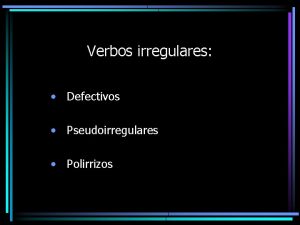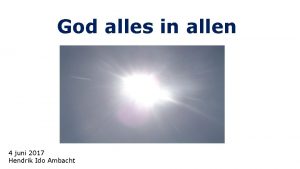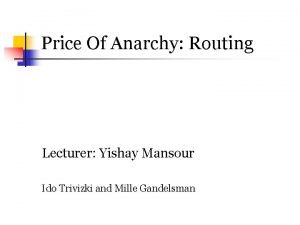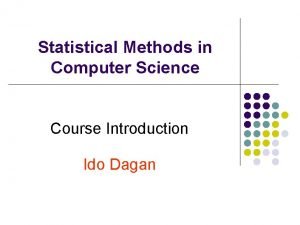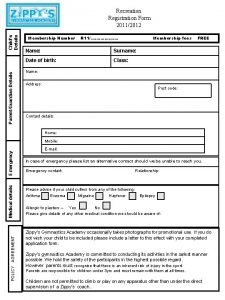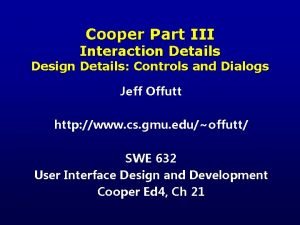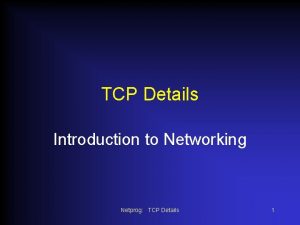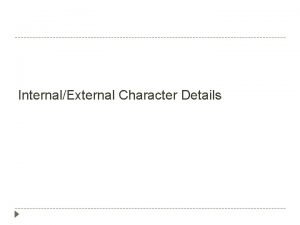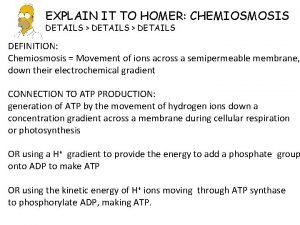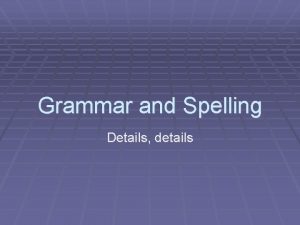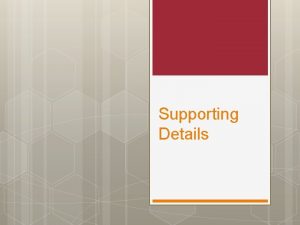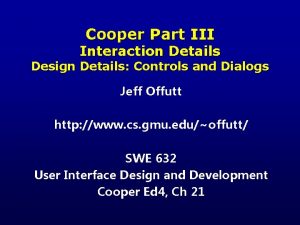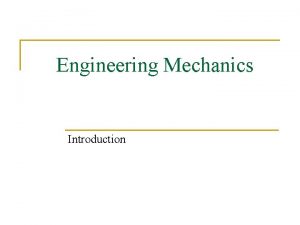Digital systems Course Details n n Lecturer Ido
























- Slides: 24

Digital systems

Course Details n n Lecturer - Ido Bergman TA - Yehuda Arav n Telephone n n Silverman : 6585956 Ross: 6585297 Email: dlocs@cs. huji. ac. il Course Site: www. huji. ac. il/~dlocs

Course Structure - Grading Exercises grading Exercise Size Number Weight Small Exercise 8 7% Total Weight 56% Large Exercise 4 11% 44%

Course Structure - Grading Total Exercise * 0. 2 + Exam Grade * 0. 8 Total Grade = max Exam Grade

Registering the course n Registed in: http: //httpdyn. cs. huji. ac. il/course-admin/dlocs/register

Course Structure Introduction - representing data 1. 2. 3. 4. 5. Representation of strings (Binary Codes). Representation of Numbers in different bases. Representation of Integer numbers (1 and 2 complement). Representation of Fixed point numbers Representation of Floating Numbers 1. 2. 3. Addition and subtraction Multiplication and division. Rounding errors and overflow

Course Structure Boolean Algebra. 1. 2. 3. 4. 5. 6. Axioms Basic Theorems of boolean algebra. Literals and Boolean functions. Various gates (nand, nor, xor and ect. ) (including multiple gates). Canonical forms. Completeness of systems 1. 2. 3. Explanation of completeness Proving that AND, NOT or OR, NOT is complete. Examples of other complete systems: 1. 2. 4. 7. NAND Friedkin and Toffoli. Provoing that a system is not complete. Simplification of representation 1. Karnaugh maps. 1. 2. Maps of 3, 4, 5, 6 variable. Indifferent combination. The table method.

Course Structure Basic Combinatorial Circuits 1. Representation of binary system in computers 1. 2. Switches 1. 2. 3. P and N switches. Construction of the elements: NOT, AND and OR. Timing of the single element (From Wakerly - Digital Design) : 1. 2. 3. 4. Positive and negative logics. Noise (the bounds of logic). Objective Different concenpts and terms in timing. Hazards - Static and Dynamic. Timing of circuit.

Course Structure Advanced Combinatorical Circuites 1. 2. 3. 4. 5. Example 1 - simple Digit decoder Example 2 - semi and full adders. Presenting the synthesis procedure for sequential circuits. Analysis. Presenting various components (not necessarily a full list): 1. 2. 3. 4. 5. 6. 7. 8. 9. 10. 11. subtractors. 4 -bit adder Ripple add Comparator Fast addition with look ahead carry. BCD adder. Multiplexer (with and without enable) and demultiplexer Encoder and Decoder (and priority decoder) with or without enable. Multiplication of binary numbers. Decimal Adder. Three State Device.

Course Structure Basic Sequential Circuits 1. 2. Synchronous and a-synchronous systems. Latches. 1. Basic SR-Latch 1. 2. 3. 4. 5. 3. Problems with a-synchrounous circuits 1. Solution 1. Time controlled Latch (Gate Latch) 1. 2. 4. 5. 1. 1 Disadvantages Solution 2. Flip-Flops 1. 2. Trigerring Flip. Flops Edge-triggred Flip-Flops. 1. 2. 5. Implementation Time diagram D-latch JK-latch T-latch. Positive edge Negative edge (master slave). Tirggering tables.

Course Structure Advanced Sqeuntial Circuits I 1. Synthesis of sequential+combinatorical circuits. 1. 2. 3. 2. Registers 1. 2. 3. 4. 5. 3. State machines - Mealy and moore The synthesis procedure. Analysis procedure. Introduction Simple registers Registers with parallel loadings Shift register with parallel loading. Counters 1. 2. 3. 4. Introduction Counting up and down. Example - Counting module 6. Ripple Counter.

Course Structure Advanced Sequential Circuits II 1. Control structures. 1. 2. 3. parallel control (Johnson counter) sequential control. ROM and RAM Memory BUS 1. 2. 3. Introduction Three states device. Bus implementation.

Course Structure Computer organization - Basics. 1. Computer design 1. 2. 3. CPU Control unit ALU

Digital system n n Machines that handles discrete information units For example: n n Computers Calculators Telephone Switches Cell phones

Implemantation Constraint n A reliable electric system has two modes: n n On Off All data must be represented under These constraints

Scheme of a Computer Control Unit Processor Storage or Memory Input Output

Representing data n n Bit – Binary digit. Can have values: n n n 1 (on) 0 (off) A string of bits can represent data

Representing numbers Number 0 1 2 3 4 5 6 7 BCD representation 000 001 010 011 100 101 110 111 Weight : 421

More number codings Number 8 4 -2 -1 2421 0 0000 1 0111 0001 2 0110 0010 3 0101 0011 4 0100 5 1011 6 1010 1100 7 1001 1101 Same value, different Coding

Error Detecting Codes n n Binary transmission are prone to errors We add some information to allow us to detect error

Parity bit – odd or even Message P (odd) P (even) 0000 1 0 0001 0 1 0010 0 1

Error detecting (even) Message 01100 Transmission 01101 Error detecting bit: 0 Ask for retransmission Odd number of 1 Error detected

Alphanumeric code Character a 8 -bit EBCDIC 1000 0001 ASCII A 1100 0001 0100 0001 1 1111 0001 0011 0001 $ 0101 1011 0010 0100 American Standard Code for Information Interchange 0110 0001

Gray code Gray Code Number 000 0 001 1 011 2 010 3 110 4
 Lecturer's name
Lecturer's name Jeannie watkins
Jeannie watkins Spe distinguished lecturer
Spe distinguished lecturer Teacher good afternoon
Teacher good afternoon Photography lecturer
Photography lecturer Lecturer in charge
Lecturer in charge Designation lecturer
Designation lecturer Designation of lecturer
Designation of lecturer Gcwak
Gcwak Lecturer name
Lecturer name Pearson lecturer resources
Pearson lecturer resources Spe distinguished lecturer
Spe distinguished lecturer Lector vs lecturer
Lector vs lecturer Lecturer in charge
Lecturer in charge Cfa lecturer handbook
Cfa lecturer handbook Lecturer asad ali
Lecturer asad ali Major details and minor details
Major details and minor details Example of major points
Example of major points Dpmi paramedical college delhi
Dpmi paramedical college delhi Fio fis fit
Fio fis fit O que é locução verbal
O que é locução verbal Ido millet
Ido millet Dr totth lászló kaposvár rendelési idő
Dr totth lászló kaposvár rendelési idő Jezus hendrik-ido-ambacht
Jezus hendrik-ido-ambacht Ado edo ido
Ado edo ido



















